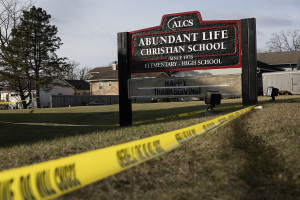How do we know the Christmas story is true?

As I write these words, Christmas morning is just a few hours away. In the U.S., Christmas is making something of a comeback. Where I live here in Middle Tennessee, the “Merry Christmas” signs and greetings outnumber “Happy Holidays” signs by a seemingly ever-widening margin.
Although Pew Research polling reveals that the percentage of Americans identifying as “Christian” has continued a gradual long-term decline (from 78% in 2007 to 63% today), one-third of Americans said their faith had grown stronger during the COVID pandemic. This was the highest percentage increase of any developed country in the world.
Conversely, the same Pew Research found that the number of Americans who identified with no religion had increased from 16% in 2007 to 29% today. Pew’s research also revealed that the percentage of Americans who prayed daily fell from 58% in 2007 to 45% today.
Currently, 40% of Americans self-identify as Protestant, while 21% are Roman Catholic. The majority of those identifying as Protestant would qualify as “Evangelical.” Evangelicals have been defined by the contours of the “Bebbington Quadrilateral,” named after David W. Bebbington, a professor of history at the University of Stirling.
Dr. Bebbington lists four main emphases that define Evangelical beliefs and convictions. First, a strong Biblicism which includes a bedrock belief that “all essential spiritual truth is to be found in its pages.” Second, Crucicentrism: a paramount emphasis on “the atoning work of Christ on the cross.”
Third, Evangelicals emphasize Conversionism, an essential belief that all individuals need to trust Jesus as their Savior and Lord and experience “conversion.” Fourth, a bedrock belief in Activism, understood as the conviction that the Gospel requires believers to be active as salt and light in the world (Matt. 5:13-16).
By size, conviction, and activity, Evangelicals are among the more visible expressions of the Christian faith in America. As a consequence of Evangelicals’ commitment to conversion, Evangelicals are “evangelistic.” As a consequence of Evangelicals’ aggressively sharing their faith, they are asked disproportionately, “How do you know the story of the Gospel is true? Did Jesus really survive the crucifixion? Is it really true He was resurrected from the dead, had a post-resurrection ministry, and ascended into heaven before multiple assembled witnesses?”
It is not enough, but it is necessary, to explain your own faith pilgrimage and relationship and experience with Jesus Christ as your Lord and Savior in answering this question. It is necessary in the sense that as the great Victorian preacher Charles Haddon Spurgeon once told his ministerial students, “They may not believe it, but they better believe that you believe it.”
As an Evangelical Christian of the Baptist persuasion, my personal relationship with the resurrected and ascended Jesus is as real as any relationship in my life. I look upon it as a privilege and an honor to share my relationship with the living Christ with others.
So, where do I go from there in answering the question, “How do you know the Gospel is true?”
I often start my answer by sharing the remarkable story of the textual transmission of the New Testament. The manuscript evidence for the integrity of the New Testament text is unprecedented prior to the invention of the printing press. More copies of the New Testament have survived and they are earlier copies than any other work from the ancient world.
The time gap between the original New Testament and first partial copies that are extant is 25 years and the total number of manuscripts is approximately 6,000. For Homer, the time gap is 500 years and 1,800 manuscripts. The time gap for Plato is 1,200 years and there are seven manuscripts. Unless we apply a completely hypocritical double standard, the New Testament has earlier and more testimony to its accuracy than any other ancient document.
As the revered and once liberal archeologist William F. Albright has said, “We can already say emphatically that there is no longer any solid basis for dating any book of the New Testament after about A.D. 80.”
The only logical explanation for this unique preservation is divine intervention. The miraculous events recorded in the New Testament actually happened, or they would have been discredited by people still alive who would have come forth and said, “I was there, and it did not happen.”
The great biblical scholar and archeologist Sir Frederick Kenyon wrote:
“The interval, then, between the dates of original composition and the earliest extant evidence becomes so small as to be in fact negligible. And the last foundation for any doubt that the Scriptures have come down to us substantially as they were written has now been removed. Thus, both the authenticity, the general integrity, of the books of the New Testament may be regarded as firmly and finally established.
“The New Testament tells us that the credibility and viability of the Christian faith stands or falls with the Resurrection.”
This Christmas we should remember that Christmas is the beginning of the story that culminates in the victory of the resurrection.
As the Old Testament sacrificial system taught and the New Testament declares in Hebrews, without the shedding of blood there is no forgiveness. To be our Savior and Lord, He had to die. The conversation in the Garden of Gethsemane makes that truth quite clear.
If there had been any other way to purchase mankind’s salvation without compromising God’s righteousness, God the perfect Father would have answered the perfect Son’s prayer and let the dreaded cross kind of death pass from Him. Golgotha was required, but without the empty tomb, it would have been a heroic, but insufficient sacrifice.
As the Apostle Paul told us in I Corinthians, “If Christ has not been raised our preaching is useless and so is our faith.” The glorious truth we can celebrate as Christians, however, is that Jesus has conquered the grave. Death and the grave have been swallowed up in the resurrection of Jesus Christ.
Unfortunately, there are increasing numbers of Americans who claim to be Christians, while at the same time denying a literal, physical resurrection of Jesus on the first Easter. This seems to me to be a complete contradiction in terms. Jesus Himself said in Luke 9:22 that He must die and be raised on the third day.
And, the Apostle Paul asserted that belief in the resurrection was essential for eternal salvation: “If thou shalt confess with thy mouth the Lord Jesus and believe in your heart that God hath raised Him from the dead, thou shalt be saved.” (Rom. 10:9)
As one commentator put it, imagine the headline, “A quarter of atheists believe in God” or “Married people who are single.” It is indeed a contradiction in terms to claim to be a Christian and not believe in the resurrection. As the prominent theologian Jaroslav Pelikan observed, “Traditionalism is the dead faith of the living, tradition is the living faith of the dead.”
Finally, what I personally believe is the most compelling left-brained, rational argument for the veracity and validity of the Christian faith is the continued faith, witness, and sacrifice of the original Apostles. Of all the people in the world, the inner circle of the Apostles had to know whether the resurrection really happened. How do you explain the continuing faith, sacrifice, and eventual martyrdom of the original Apostles unless the resurrection really happened?
People do not sacrifice their lives for something they know was untrue and they had to know whether it was true or not. This group of dispirited, broken-hearted men was huddled together in Jerusalem, believing the dream was dead and there He was, with them, eating before them and asking them to touch the wounds in his hands and side.
The only rational explanation is that it happened. This Christmas let us all rejoice with Henry Wadsworth Longfellow:
I heard the bells on Christmas Day,
Their old familiar carols play
And wild and sweet the words repeat,
Of peace on earth, good will to men.I thought how as the day had come,
The belfries of all Christendom
Had roll’d along th’unbroken song
Of peach on earth, good will to men.And in despair, I bow’d my head.
“There is no peace on earth,” I said.
“For hate is strong and mocks the song
Of peace on earth, good will toward men!”Then pealed the bells more loud and deep;
God is not dead, nor doth He sleep.
The wrong shall fail, the right prevail,
With peace on earth, good will to men.‘Til ringing, singing on its way,
The world revolved from night to day,
A voice a chime, a chant sublime
Of peace on earth, good will to men.
Amen and Amen!
Dr. Richard Land, BA (Princeton, magna cum laude); D.Phil. (Oxford); Th.M (New Orleans Seminary). Dr. Land served as President of Southern Evangelical Seminary from July 2013 until July 2021. Upon his retirement, he was honored as President Emeritus and he continues to serve as an Adjunct Professor of Theology & Ethics. Dr. Land previously served as President of the Southern Baptist Convention's Ethics & Religious Liberty Commission (1988-2013) where he was also honored as President Emeritus upon his retirement. Dr. Land has also served as an Executive Editor and columnist for The Christian Post since 2011.
Dr. Land explores many timely and critical topics in his daily radio feature, “Bringing Every Thought Captive,” and in his weekly column for CP.





























